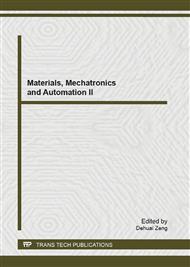[1]
Jun Ma, Liping Qiu. The BAF and Its Research Progress [J]. Environmental Engineering, 2002,20(3):7-11.
Google Scholar
[2]
Whiteley A S, Bailey MJ. Bacterial community structure and physiological state within an industrial phenol bioremediation system [J] . Appl Environ Microbiol , 2000 , 66 (6) : 2400-2407.
DOI: 10.1128/aem.66.6.2400-2407.2000
Google Scholar
[3]
Wagner M, Amann R, Lemmer H. Probing activated sludge with oligonucleotides specific for proteobacteria : inadequacy of culturedependent methods for describing microbial community structrue[J] . Appl Environ Microbiol , 1993 , 59 (5):1520-1525.
DOI: 10.1128/aem.59.5.1520-1525.1993
Google Scholar
[4]
Frias-Lopez J,Klaus J S,Bonheyo G T,et al. Bacterial community associated with black band disease in corals.Applied and Environmental Microbiology, 2004,70(10):5955-5962.
DOI: 10.1128/aem.70.10.5955-5962.2004
Google Scholar
[5]
Osborn A M,Moore E R B,Timmis K N. An evaluation of terminal-restriction fragment length polymorphism (TRFLP) analysis for the study of microbial community structure and dynamics. Environmental Microbiology,2000,2(1):39-50.
DOI: 10.1046/j.1462-2920.2000.00081.x
Google Scholar
[6]
Hartmann M,Widmer F. Reliability for detecting composition and changes of microbial communities by TRFLP genetic profiling . FEMS Microbiology Ecology,2008,63(2): 249-260.
DOI: 10.1111/j.1574-6941.2007.00427.x
Google Scholar
[7]
Lee D H, Zo Y G, Kim S J. Nonradioactive Methods to Study Genetic Profiles of Natural Bacterial Communities by PCR-single-strand Conformation Polymorphism [J]. Appl. Environ. Microbiol,1996,62:3112-3120.
DOI: 10.1128/aem.62.9.3112-3120.1996
Google Scholar
[8]
Delong E F,Wickham G S,Pace N R. Phylogenetic stains: ribosomal RNA-based probes for the Identification of single cells. Science,1989,243: 1360-1363.
DOI: 10.1126/science.2466341
Google Scholar
[9]
Defeng Xing, Nnaqi Ren, Jianzheng Li. Application and Progress of FISH in Environmental Microbiology [J]. Environmental Sciences,2003,16(3):55-58.
Google Scholar
[10]
Lee N, Jansen JL, Aspegren H, et al. Population dynamics in wastewater treatment plants with enhanced biological phosphorus removal operated with and without nitrogen removal. Water Science and Technology, 2002, 46(1-2):163−170.
DOI: 10.2166/wst.2002.0472
Google Scholar
[11]
PYNAERT K, SMETS B F , BEHEYDT D , et al. Start up autotrophic nitrogen removal reactor via sequential biocatalyst addition[J]. Environ Sci Technol, 2004, 38:1228-1235.
DOI: 10.1021/es030081+
Google Scholar
[12]
TSUNEDA S , TATSUO N , HOSHINO T, et al. Characterization of nitrifying granules produced in an aerobic up flow fluidized bed reactor [J]. Wat Res, 2003, 37:4965-4973.
DOI: 10.1016/j.watres.2003.08.017
Google Scholar
[13]
Yingying Qian, Daotang Li, Hong Yang. The Bacterial Population Diversity and Community Structure in Water Biological Pretreatment Reactor [J]. Application and Environmental Biology, 2007, 13 (1):104-107.
Google Scholar
[14]
Coskuner G,T Curtis.In situ characterization of nitrifiers in an activated sludge plant:detection of Nitrob acter Sp[J].Journal of Applied Microbiology,2002,93(3):431-437.
DOI: 10.1046/j.1365-2672.2002.01715.x
Google Scholar
[15]
Juretschko S, et al., Combined molecular and conventional analyses of nitrifying bacterium diversity in activated sludge: Nitrosococcusmobilis and Nitrospira like bacteria as dominant populations. Applied and Environment al Microbiology [J], 1998, 64(8):3042-3051.
DOI: 10.1128/aem.64.8.3042-3051.1998
Google Scholar
[16]
Abed R M, Zein B, Al-ThukairA, et al. Phylogenetic diversity and activity of aerobic heterotrophic bacteria from a hypersalineoil-polluted microbial mat [J]. Systematic and Applied Microbiology, 2007, 30(4):319-330.
DOI: 10.1016/j.syapm.2006.09.001
Google Scholar
[17]
Ju retschko S, Loy A, Lehner A , et a l. 2002. The microbial community composition of a nitrifying-denitrifying activated sludge from an industrial sewage treatment plant analyzed by the full-Cycle rRNA approach[J]. Systematic Applied Microbiology, 25: 84-99.
DOI: 10.1078/0723-2020-00093
Google Scholar
[18]
KINDA ICHI T, OKABE I T. Eco-physiological Interaction Between Nitrifying Bacteria and Heterotrophic Bacteria in Autotrophic Nitrifying Biofilms as Determined by Microautoradiography- fluorescence in Situ Hybridization[J]. Appl Environ Microbiol, 2004,70: 1641-1650.
DOI: 10.1128/aem.70.3.1641-1650.2004
Google Scholar
[19]
Wagner M, Amann R, Lemmer H, et al. 1995. In situ identification of ammonia-oxidizing bacteria[J]. Syst. Appl. Microbiol., 18:251-264.
Google Scholar
[20]
Baosheng Sun, Bin Zhang, Qing Wu. Apply PCR-DGGE and analyze microbial community diversity in MBR [J]. Tianjin University, 2008,41 (3) :356-361.
Google Scholar
[21]
Zumstein E , Moletta R , Godon J J . Examination of two years of community dynamics in an anaerobic bioreactor using fluorescence polymerase chain reaction (PCR) single-strand conformation polymorphism analysis[J].Environ Microbiol, 2000 , (2):69-78.
DOI: 10.1046/j.1462-2920.2000.00072.x
Google Scholar


